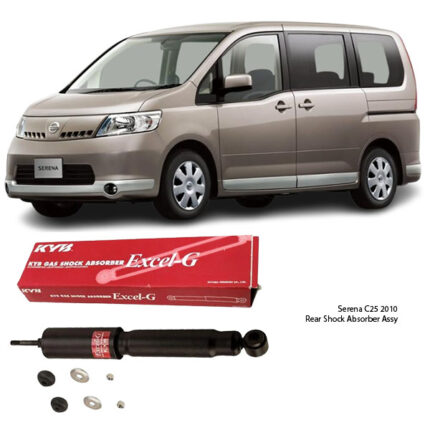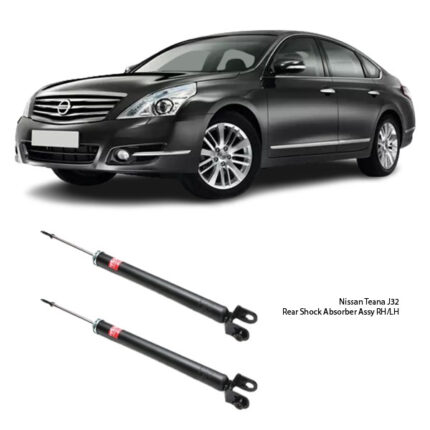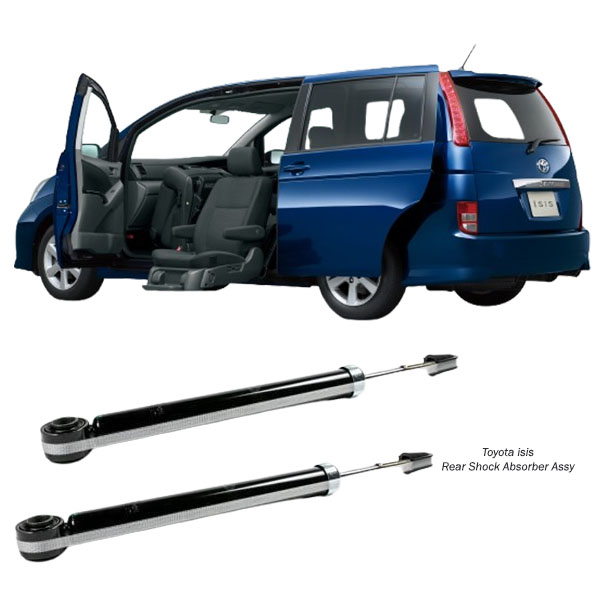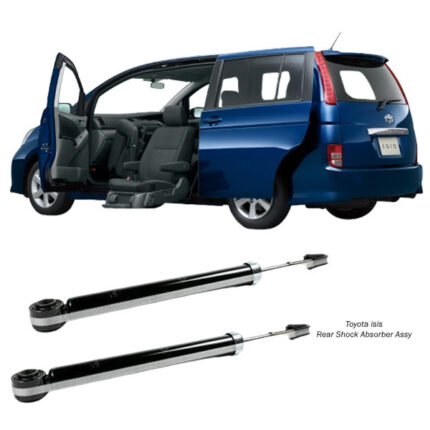Get Toyota isis Rear Shock Absorber Assy 348075 in Kenya
The rear shock absorber assembly is a critical suspension component that ensures a smooth and controlled ride by absorbing road impacts, reducing vibrations, and maintaining tire contact with the road. Shock absorbers play a vital role in vehicle stability, handling, and passenger comfort.
A well-functioning rear shock absorber assembly enhances safety, prevents premature tire wear, and protects other suspension components from excessive stress. In this comprehensive guide, we’ll cover how rear shock absorbers work, types, symptoms of failure, replacement, and maintenance tips.
What is a Rear Shock Absorber Assembly?
The rear shock absorber assembly consists of:
Shock Absorber – Controls the up-and-down movement of the suspension.
Mounting Bushings – Absorbs minor vibrations and prevents metal-to-metal contact.
Shock Mount – Secures the shock absorber to the vehicle’s chassis and suspension.
Coil Spring (if part of a strut assembly) – Supports the vehicle’s weight.
The shock absorber itself is a hydraulic or gas-filled cylinder that dampens road shocks, preventing the vehicle from bouncing excessively.
How Does a Rear Shock Absorber Work?
Shock absorbers don’t support the vehicle’s weight—instead, they control the motion of the suspension and springs. Here’s how they function:
Compression Phase (Absorbing Impact)
When the vehicle hits a bump, the rear wheels move upward, compressing the shock absorber. The hydraulic fluid inside the shock flows through small valves, resisting rapid movement and absorbing the impact.
Rebound Phase (Returning to Position)
Once the wheel moves past the bump, the shock absorber extends, controlling the downward movement and preventing excessive bouncing.
This continuous compression and rebound cycle helps maintain tire contact with the road, ensuring better control and stability.
Types of Rear Shock Absorbers
There are several types of rear shock absorbers, each designed for different driving conditions and vehicle types:
Twin-Tube Shock Absorbers
Most common type.
Features two chambers (inner & outer) for hydraulic fluid and gas.
Provides comfortable ride quality.
Affordable but may fade under extreme conditions.
Gas-Charged Shock Absorbers
Similar to twin-tube but filled with nitrogen gas.
Reduces foaming & fade, improving performance.
Ideal for daily drivers and light off-road use.
Monotube Shock Absorbers
High-performance design with a single chamber.
Offers better heat dissipation & response.
Used in sports cars & performance vehicles.
Coilover Shock Absorbers
Combines shock absorber & coil spring.
Allows ride height & stiffness adjustments.
Common in racing & off-road vehicles.
Adjustable Shock Absorbers
Allows drivers to adjust damping force.
Ideal for tuning ride comfort & handling.
Symptoms of a Failing Rear Shock Absorber
A worn-out or damaged rear shock absorber can lead to poor handling and reduced safety. Watch out for these warning signs:
Excessive Bouncing
If your car bounces multiple times after hitting a bump, the shocks aren’t absorbing impacts properly.
Nose-Diving During Braking
Worn shocks cause the rear end to lift and front end to dip excessively when braking.
Swerving or Instability at High Speeds
If your car feels unstable or wobbly, especially on highways, it’s a sign the shocks aren’t controlling suspension movement.
Uneven or Premature Tire Wear
Bad shocks cause irregular tire contact with the road, leading to cupping or bald spots.
Leaking Hydraulic Fluid
If you see oil leaks on the shock absorber body, the internal seals are worn, and the shock is no longer effective.
Clunking or Rattling Noises
Loose or failing shocks can cause knocking sounds when driving over rough roads.
When to Replace Rear Shock Absorbers?
Every 80,000 – 100,000 km (50,000 – 60,000 miles) for regular use.
Earlier if driving on rough roads, carrying heavy loads, or towing.
If you notice any of the above symptoms.
How to Replace Rear Shock Absorbers?
Tools Needed:
Socket Wrench Set
Jack & Jack Stands
Penetrating Oil (for rusty bolts)
Torque Wrench
New Rear Shock Absorbers
Step-by-Step Guide:
Park on a Flat Surface & Secure the Vehicle
Engage the parking brake and use wheel chocks.
Lift the Rear End
Use a jack to raise the vehicle and secure it with jack stands.
Locate & Remove the Old Shocks
Spray penetrating oil on bolts if they’re rusted.
Use a wrench to loosen & remove the upper and lower bolts.
Install the New Shock Absorbers
Align the new shock in place.
Tighten bolts to manufacturer torque specs.
Lower the Vehicle & Test Drive
Check for smooth ride quality & stability.
How to Maintain Rear Shock Absorbers?
Inspect Shocks Every 20,000 km – Look for leaks & wear.
Check Tire Wear Patterns – Uneven wear = possible shock issues.
Avoid Overloading Your Vehicle – Excessive weight strains the suspension.
Drive Carefully on Rough Roads – High impact accelerates wear.
Replace Shocks in Pairs – Ensures balanced handling & stability.
Follow us on Facebook for more parts.




